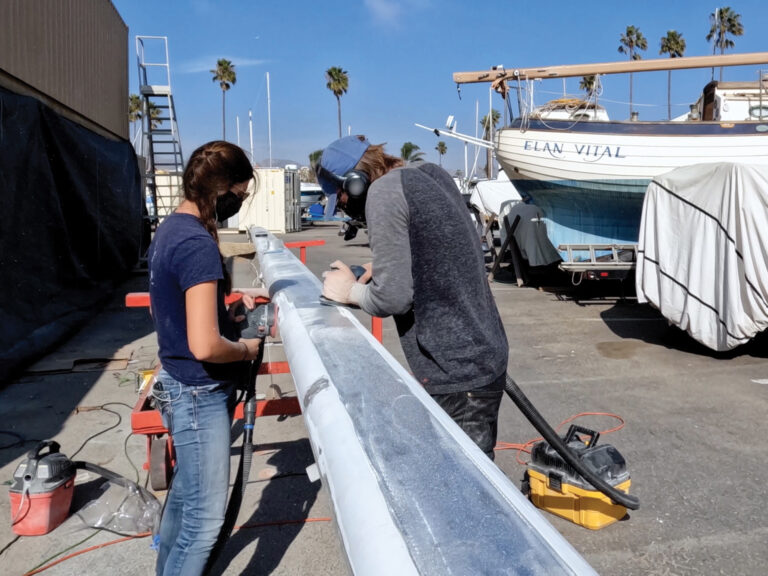
The most important word when jibing is control. The helmsperson, sail trimmers and entire crew need to be diligent. The mainsail boom will swing across the boat with great force if important steps are not taken. There are many cases of serious injuries to unsuspecting crew who were hit in the head by the boom, or who tumbled overboard with the rapid change of course.
By contrast, completing a successful jibe provides great satisfaction when executed with precision.
The best time to jibe is when a boat is sailing at full speed. The force of the apparent wind on a sail is less when sailing swiftly, which makes steering easy. The reason to jibe is to head on a more direct course toward a desired destination, or to take advantage of a shift in wind.
In advance of a jibe, one person, who is usually steering, should hail the crew about the intention to jibe. This is the proper time to assign specific duties to each crewmember so that everyone is clear about their role during the jibe.
Once in proper position, the crew should stand by for a countdown to the maneuver. The helmsperson should turn the boat slowly, leaving no one caught off guard. Verbally state the new course, and visually look at any references, such as objects on shore or other boats, to know where the boat will be heading after the jibe.
The sail trimmer should trim in the sails as the boat makes the turn. This is particularly important with the mainsail. Keep the sail under control so that the boom doesn’t swing wildly across the deck. Trim in the mainsail as the boat turns, and let it out rapidly as the sails fill on the new course. Just before the mainsail swings over, the helmsperson should hail, “Heads!” This will alert the crew to keep their heads low.
In heavy wind, the helmsperson can execute an S-course jibe. Just as the mainsail is swinging across, the helmsperson turns the boat briefly in the direction the mainsail is heading. This action depowers the wind’s force on the mainsail. Once the boat is on the new course, the mainsail can be eased out to its most efficient position. The course that is steered is the shape of the letter S.
In winds less than 10 knots, most boats will jibe through 70 to 90 degrees. In stronger winds, a boat will jibe through 60 degrees or less. In a good blow, I suggest easing off the boom vang and securing the traveler in one place before jibing. This will depower the pressure on the sails and the rig.
The jibing process is more complicated when a spinnaker is being flown. If the spinnaker is symmetrical with a spinnaker pole, then the helmsperson should be particularly careful when steering. The foredeck crew needs to exert downward and forward pressure on the spinnaker pole to keep it under control as it is being rehooked to the mast.
Avoid rapid turns. Give your crew adequate time to shift the spinnaker pole. The sail trimmer in the cockpit is positioned to keep the sail full. Good teamwork is the key.
In recent years, the asymmetrical spinnaker has become a popular sail. I find that inside jibes are generally more efficient. This is when the sail passes inside the fore-triangle. The sail trimmer eases out the old sheet so that there is plenty of line to trim on the new jibe. The turn of the boat is usually a little faster than when jibing with a symmetrical sail, but it should not be any faster than the sail trimmer can move the sail from one side of the boat to the other. Continue changing course smoothly and constantly when jibing with an asymmetrical spinnaker. A pause can cause the sail to wrap.
I find it interesting how many modern yachts resort to roller furling systems to handle forward sails. This applies to headsails and staysails. The sail is simply rolled up before jibing and rolled back out after the jibing maneuver is complete.
I suppose I could add a technique or two for schooners and other multimast boats. For example, schooners set a gollywobbler between the masts. On some schooners, it is best to have two of these quadrilateral sails ready to set on either jibe. When it is time to change course and jibe, take down one and hoist up the other on the new jibe. You just need two sails. But that is a story for another day.
5 keys to safe jibing
- Give the crew ample warning that a jibe is about to take place.
- Assign each crewmember a specific job.
- Keep the mainsail under control; don’t let the boom fly across the boat.
- Look for a reference point on land to head for on the new course.
- Do not turn the boat too quickly.
Hall of Fame sailor Gary Jobson is a CW editor-at-large.








